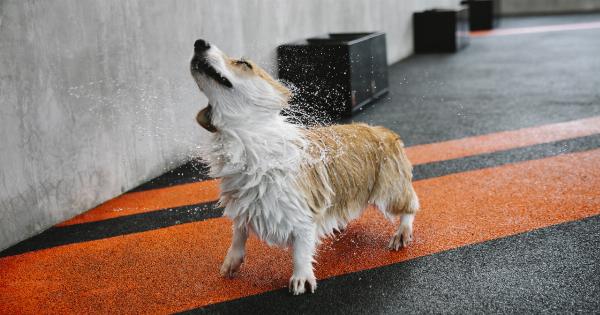Piloerection, commonly known as “hair standing on end” or “goosebumps,” is a fascinating phenomenon that occurs in dogs.
It refers to the erect state of the hair follicles, causing the hair on the dog’s body to appear raised. While it is a normal response in certain situations, piloerection in dogs can also indicate an underlying health issue or emotional distress.
In this article, we will delve into the various causes of piloerection in dogs, helping you understand when it is a natural reaction and when it may require veterinary attention.
Fear or Anxiety
Dogs, like humans, can experience fear and anxiety. When a dog feels threatened or scared, piloerection can occur as a natural response. This reaction is often accompanied by other signs of stress such as trembling, panting, or cowering.
Common triggers for fear or anxiety in dogs include loud noises (thunderstorms, fireworks), unfamiliar environments, and certain people or animals. If your dog frequently exhibits piloerection in such situations, it is important to provide a safe and secure environment to ease their worries.
Pain or Discomfort
When dogs are in pain or discomfort, piloerection can be an indication of their distress. It may occur due to injury, infection, or an underlying medical condition.
Some dogs may also exhibit piloerection when experiencing digestive disturbances, urinary tract issues, or musculoskeletal problems. If you notice persistent piloerection or other signs of distress, consulting with a veterinarian is highly recommended. They can help identify and address the cause of your dog’s discomfort.
Illness or Disease
Piloerection can be a result of various illnesses or diseases in dogs. Certain infections, such as canine distemper or parvovirus, can lead to piloerection, especially during the early stages of the disease.
Endocrine disorders, including hypothyroidism or adrenal disorders, may also cause piloerection as a symptom. Additionally, dogs suffering from systemic inflammatory conditions, autoimmune diseases, or cancer may exhibit hair standing on end.
If your dog shows no other obvious signs of fear or discomfort, an underlying illness could be the cause of the piloerection.
Temperature Regulation
In some cases, piloerection in dogs serves a natural purpose: temperature regulation. Dogs have a layer of fur that traps air against their skin, providing insulation.
When they are cold, piloerection helps to trap even more air, acting as an additional layer of insulation. By raising their hair, dogs can increase their body heat retention. Conversely, when dogs become overheated, piloerection could be their way of dissipating heat more efficiently by trapping cool air against their skin.
It is important to monitor your dog’s overall body language and behavior to determine if piloerection is a temperature regulation response.
Social Interaction and Excitement
Dogs are highly social animals that rely on communication through body language. Piloerection can be a part of their nonverbal communication, typically indicating excitement.
When dogs encounter something or someone they are particularly interested in, their hair may stand on end. This response is often accompanied by a wagging tail, bright eyes, and an overall alertness. It is essential to understand your dog’s individual behavior and body language to differentiate excitement-related piloerection from other causes.
Allergic Reactions
Allergies can trigger piloerection in dogs, similar to how our skin can react with goosebumps when exposed to allergens.
Dogs can develop allergies to certain foods, environmental factors (such as pollen or dust mites), or even specific materials they come into contact with. If your dog frequently exhibits piloerection along with excessive scratching, redness, or swelling, it is advisable to consult with a veterinarian to identify and manage the underlying allergy.
Hormonal Changes
Hormonal imbalances in dogs can manifest in various ways, including piloerection. Female dogs may experience piloerection during their heat cycle due to hormonal fluctuations.
Additionally, dogs with adrenal gland issues or hormonal abnormalities, such as Cushing’s disease, may display piloerection as a symptom. It is crucial to work closely with a veterinarian to diagnose and manage any hormonal changes that may be causing piloerection in your dog.
Frustration or Aggression
Piloerection can be an expression of frustration or aggression in dogs. As part of their instinctive behaviors, dogs may raise their hair along their backs when they feel challenged or need to assert dominance.
This response is often accompanied by a stiff posture, intense eye contact, growling, or barking. Understanding your dog’s body language is crucial in such situations to prevent any potential conflicts and ensure a safe environment for everyone involved.
Medication Side Effects
Certain medications or medical treatments can cause piloerection as a side effect. In some cases, medications that affect the nervous system or induce changes in hormones can trigger hair standing on end.
If you notice piloerection in your dog shortly after starting a new medication or undergoing a medical procedure, it is crucial to consult with your veterinarian. They can evaluate the potential side effects and adjust the treatment plan if necessary.
Nervous System Disorders
In rare cases, piloerection can be a symptom or result of nervous system disorders in dogs. Neurological conditions, such as epilepsy or brain tumors, may cause abnormal hair follicle responses.
If your dog’s piloerection is accompanied by other neurological signs like seizures, coordination issues, or changes in behavior, it is vital to seek veterinary attention promptly. Early diagnosis and treatment can lead to better outcomes for dogs with nervous system disorders.
Conclusion
Piloerection, or the erect state of a dog’s hair follicles, can occur due to various causes.
While it can be a normal response to fear, excitement, or environmental factors, it can also indicate underlying health issues, discomfort, or emotional distress. Understanding the potential causes of piloerection is essential for dog owners to ensure their pets’ well-being. Always monitor your dog’s behavior, body language, and overall health.
If you have concerns or notice persistent piloerection without an obvious explanation, consult with a veterinarian to determine the underlying cause and provide appropriate care.






























